Many people know that a heat pump with less energy consumption is better for the environment and keeps their energy bills lower. Unfortunately, the majority don’t know what factors make that possible. And if they do, not to a great extent.
That’s mainly due to the jargon or acronyms used by the industry professionals that consumers usually find difficult to understand. Two common terms used in HVAC when talking of energy efficiency rating are SEER and HSPF.
While many people are particularly familiar with the SEER rating and its relation to energy efficiency, HSPF is equally essential to consider when choosing a cooling or heating system.
This article will explore the two acronyms—SEER and HSPF and why both are important considerations when installing an HVAC system.
TL;DR: SEER vs HSPF

SEER
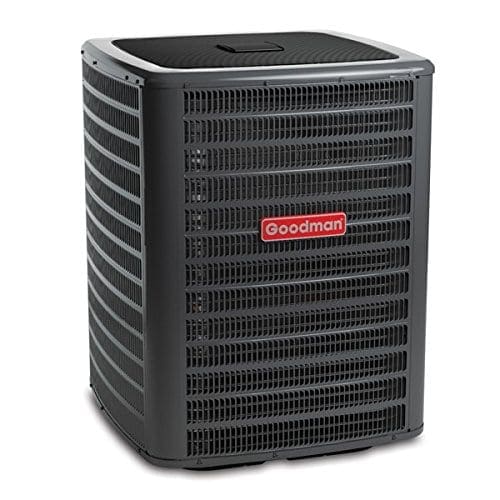
HSPF

Pros
SEER
A wide range of efficiency rating ranges of 13-22 giving more options for different budgets
The wide range of SEER ratings provides more options for cooling on different room sizes
Simple calculation of energy-efficiency rates
HSPF
No big difference in range ratings; thus, no significant variation on efficiency ratings
Easy to calculate the efficiency rating of a heat pump
Suitable for larger heating spaces since most high HSPF ratings mean multi-zone mini-split units
Cons
SEER
High SEER also depends on other factors such as installation and the entire HVAC system to save energy
High SEER rating is the most efficient but also expensive to acquire upfront
Does not give an accurate energy efficiency rating
HSPF
Limited efficiency range options to choose—7.7-10
Highly depends on other HVAC components such as home ductwork and system installation for enhanced energy savings
You may need a bigger unit which costs more for higher HSPF ratings (multi-zone mini-split units may not be appropriate for smaller homes)
Best For
SEER
The efficiency rating check for summer cooling needs
HSPF
The efficiency rating check for heating in winter
What is a SEER and How is the SEER Calculated?
SEER is an acronym for Seasonal Energy Efficiency Ratio. The SEER rating system was started by the Air Conditioning, Heating, and Refrigeration Institute (AHRI) for determining the cooling efficiency of air conditioners and heat pumps.
The SEER rating is a common term in HVAC systems used to measure a heat pump’s or a central cooling system’s energy efficiency. Most modern HVAC systems have SEER ratings ranging between 13 and 22—the standard acceptable ratings across many states.
Some modern HVAC systems have up to a maximum SEER rating of 42.
The higher the SEER rating, the more energy-efficient your central cooling system is. HVAC systems with high SEER ratings also cost more to acquire but are cheaper to operate as they use very little electricity.
Below are a few basics you may need to know about a system’s SEER.
- SEER ratings are read using “up to” the amount of efficiency. For instance, a 22 SEER system is up to 22 SEER efficiency.
Proper installation is key to a unit level of energy efficiency. A high-SEER system with poor installation has no significant difference from a low-SEER system properly installed.
A device with high SEER performs better when paired with proper equipment— in the entire HVAC system. Key components include proper ductwork, ventilation, a high-efficiency furnace, or an air handler.
SEER Energy Savings Calculator
Once you know that a higher SEER rating equals more savings, it’s critical to understand how much your system saves.
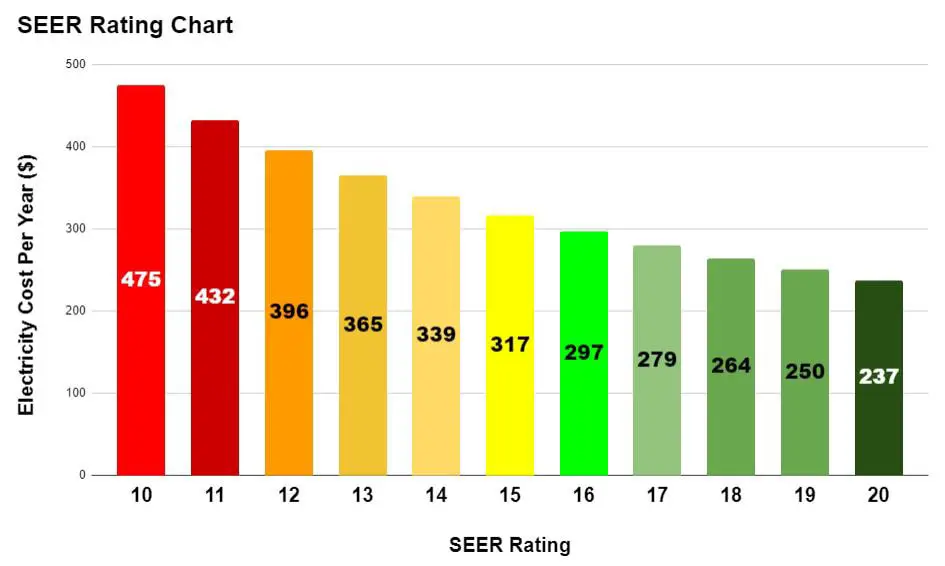
To determine your systems efficiency ratio, divide the average cooling output ratio by the energy usage in watts per hour.
What is a HSPF and How is the HSPF Rating Calculated?
HSPF is short for Heating Seasonal Performance Factor. Just as SEER rating is a metric determining cooling efficiency, HSPF works in the same way in determining heating efficiency for air-source heat pumps. AHRI also developed the HSPF rating system.
A heat pump with a high HSPF rating draws less energy for an equal heating effect, which means you’ll pay less in electricity bills. Modern systems have between 7.7 and 10 HSPF ratings.
Although there are some with more than 10 HSPF, 7.7 is the federal minimum in the US. An 8.5 HSPF is a good rating required as the minimum to earn the Energy Star label for mini-split heating systems and 8.2 HSPF for single-phase heat pumps.
HSPF Savings Chart
To understand HSPF as a metric of energy efficiency usually measured throughout a winter heating season, we need to consider:
- Electricity spent on heating (power in kilowatts-hour)
- Heating effect (heating capacity-BTUs)

For instance, if you are heating a 2,000sq. Ft. home for three winter months, you may spend 25,000 kWh. Powering a heat pump with these kilowatts-watts produces a total of 175,000,000 BTU of heating.
The HSPF is thus calculated as:
HSPF = Heating Effect (BTUs) / Electricity Spent (Wh)
Note that we use Watt-hour and not kilowatt-hour, and therefore the conversion is 1kWh = 1,000 Wh. These numbers used in the example become:
HSPF = 175,000,000 BTU / 25,000,000 Wh = 7
So, the HSPF of the heat pump is 7. To determine how much was spent on electricity, we multiply the average cost per kWh by kilowatts-hour required to warm a home.
The average price per kWh in the US is $0.1319, which now translates:
$0.1319 x 25,000 = $3,298 per heating season.
Relevant Characteristics Between the SEER and HSPF
SEER vs. HSPF
Compare by tapping or clicking below!

Acronym
SEER
Seasonal Energy Efficiency Ratio
HSPF
Heating Seasonal Performance Factor
HVAC Utility Measure
SEER
Cooling
HSPF
Heating
Range of Rating
SEER
13-22
HSPF
7.7-10
Energy Star Level
SEER
14.5
HSPF
8.2
Applies To
SEER
Heat Pumps, Air Conditioners
HSPF
Heat Pumps (Air Source Heat Pumps)
Factors Used in Calculation
SEER
- Total BTUs of heat removed from spatial air
- Total electrical energy in Watt-hours used by the device during cooling
HSPF
- Total BTUs of heating energy
- Total electrical energy in Watt-hours used by the heat pump during heating
Similarities and Differences
HVAC systems comprise many components determining energy efficiency during heating and cooling seasons, directly or indirectly impacting efficiency levels.
Below is a breakdown of differences and similarities of various energy-efficiency determinants in an HVAC unit.
SEER and HSPF Differences
- Acronym: SEER denotes Seasonal Energy Efficiency Ratio, used to measure an HVAC system’s cooling efficiency. HSPF stands for Heating Seasonal Performance Factor, used in calculating a heat pump’s heating efficiency.
- Efficiency Rating Range: SEER rating has a minimum rating of 13 and a maximum of 22, with some going up to 42 SEER. On the other hand, HSPF has a minimum rating of 7.7 and a maximum of 10.
- Energy Star Level: The US federal law grants systems with up to 14.5 SEER efficiency or more an energy star level.
HVAC systems must be at least 8.2 HSPF for single-phase heat pumps and up to 8.5 HSPF for mini-split heating systems to earn the Energy Star label.
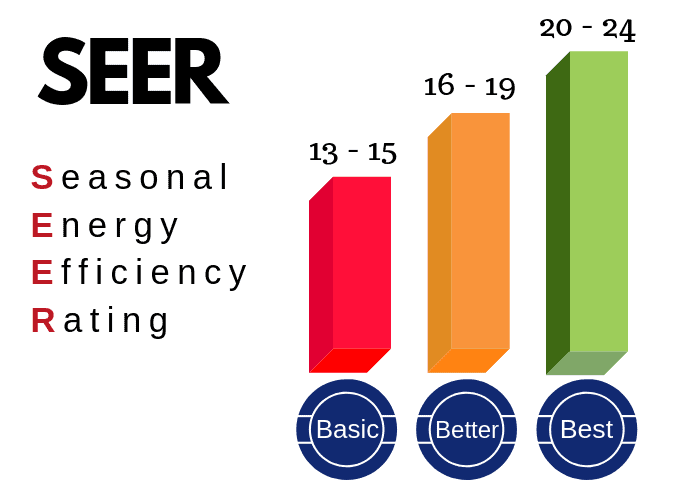
SEER and HSPF Similarities
- Energy Efficiency Rating: Both SEER and HSPF measure energy efficiency ratings, whereby the higher the rating, the more efficient the system. A 22-SEER is more efficient than a 13-SEER unit, the same way a 7.7-HSPF is less efficient than a 10-HSPF heating system.
- Efficiency calculation: The SEER is calculated by dividing the total cooling amount of an air conditioner for the season by the total electricity consumption during that period.
Similarly, HSPF is the total heating needed for the heating season in British Thermal Units (BTUs) divided by the electricity consumed for the same period.
- Dependence: Both SEER and HSPF depend on other HVAC components such as proper installation, home ductwork, and ventilation for maximum energy savings.
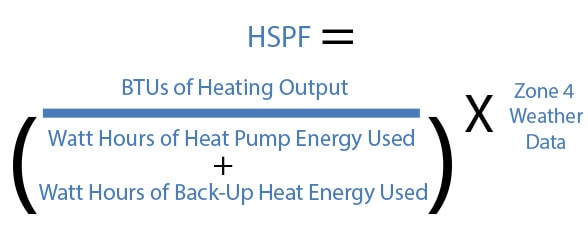
What About EER and AFUE?
EER is an acronym for Energy Efficiency Ratio used to measure an air conditioner’s efficiency. The EER is usually the cooling capacity ratio in British Thermal Units (BTUs) per hour to the energy input in watts.
The EER system was also developed by AHRI in 1975, then called the Air Conditioning & Refrigeration Institute.
An air conditioner’s efficiency can be gauged based on its EER value. The higher the value, the better and more efficient the AC is.
To calculate the EER, you’ll need to consider the two metrics—power and capacity. Divide the air conditioner’s capacity by its power consumption.
Here’s the equation:
EER = Capacity (in BTUs) / Power (in W)
For instance, a 10,000 BTU mini-split air conditioner powered by 1000W is calculated as:
EER rating = 10,000 BTU / 1,000W = 10
So, for every 1W of energy provided to the air conditioner, the air conditioner gives 10 BTU of cooling effect. The average EER for a portable air conditioner unit is 8.5. Anything below may not be a good choice.
AFUE, on the other hand, stands for Annual Fuel Utilization Efficiency. It measures A furnace’s combustion efficiency. AFUE is determined in percentage (up to 100%) to signify the amount of usable heat a furnace produces.
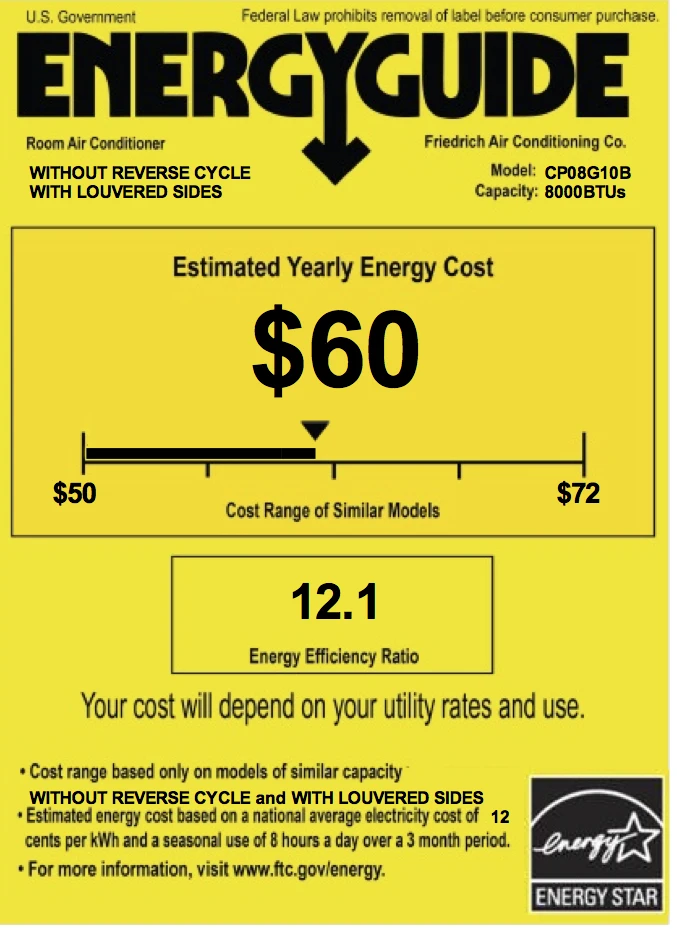
The AFUE rating system was developed by ASHRAE, the American Society of Heating, Refrigerating, and Air-Conditioning Engineers.
Here’s a simple analogy to understand how furnace heating is produced and used.
Depending on a stove or fireplace, the firewood heating efficiency rate is between 45% and 65%. That means that only 45 to 65 percent of the wood is turned into heat. The rest is just flame to show there’s heating in progress.
In furnace heating, up to 80% turns into heat while the remaining 20% is lost.
Minimum standard installation requirements depend on the state where you live. It could be as low as 80 or go as high as 90%, with the highest furnace efficiency rating reaching up to 98%.
However, it’s important to know that a high-efficiency rating may require you to reconsider your equipment pairing.
For instance, for furnaces, you may need to change the ventilation (a traditional chimney flue to a PVC pipe) to cater to the efficiency difference between the older furnace and the new one.
Most modern furnaces have higher AFUE ratings.
Systems with low heat wastage of 20% and below and tend to be more expensive. They are more advanced than most old furnaces, with an AFUE rating of below 80%. High or low AFUE ratings will depend on the needs of each home.
Bottom Line
From the above exhaustive comparison, it’s clear that both SEER and HSPF ratings are important considerations working side by side in determining the energy efficiency of air conditioners and heat pumps.
When buying an air-source heat pump, you’ll want to check its SEER and HSPF ratings. You should check for the SEER value when purchasing an air conditioner for your home or business premises.
While higher ratings are always better in each case, proper installation and equipment pairing are also critical factors.
People Also Ask
Both SEER and HSPF measure energy efficiency in an HVAC system. As a result, it’s easy to confuse what to look out for, particularly when making a purchase.
Below are answers to common questions about SEER and HSPF in an HVAC system.
The minimum allowable HSPF rating for an HVAC system is 7.7. However, the HSPF rating of 8.2 and above qualify for the US EPA’s Energy Star label award, thus making it a good rating for a heating system.
The higher the SEER rating, the more energy-efficient the system will be.
To earn an Energy Star label, the SEER must exceed 14.5. However, most technicians consider a SEER rating of between 16-18 as good. But, if you can afford a 20+ seer, the better. You’ll, however, need to pay more.
An HVAC system’s performance is rated as excellent depending on how much you can save on energy. A higher SEER is, thus, considered more energy-efficient, which translates to low energy bills.
However, better cooling depends more on the size of the HVAC unit, which includes the amount of heat BTU per hour needed to cool a space. Other factors include room layout, indoor air handler direction, and the size and type of ventilation.
SEER measures cooling, whereas HSPF measures heating.
So, it all depends on the season. People living in cold winter regions that experience mild summer will find HSPF more valuable in a heat pump. Those residing in mild winter regions will prefer units with a high SEER rating.
However, keep in mind that most modern HVAC systems can be used both in winter and summer. As a result, such units have SEER and HSPF ratings balanced at reasonable ranges for both seasons.
